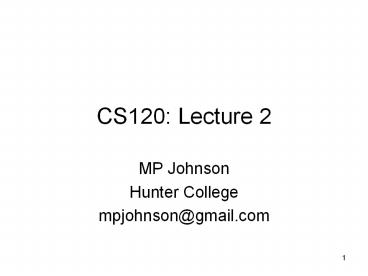CS120: Lecture 2 - PowerPoint PPT Presentation
1 / 27
Title:
CS120: Lecture 2
Description:
mpjohnson_at_gmail.com. 2. Agenda: data. Review ops/gates ... 0. Just use sign bit. How to add/sub? 1's comp. How to add/sub? Two 0's. 2's comp. How to add/sub? ... – PowerPoint PPT presentation
Number of Views:55
Avg rating:3.0/5.0
Title: CS120: Lecture 2
1
CS120 Lecture 2
- MP Johnson
- Hunter College
- mpjohnson_at_gmail.com
2
Agenda data
- Review ops/gates
- Abstract storage flipflops
- Storage methods
- representation
- Test
- Images
- Sound
- Numbers
- Positive
- Negative
- Fractions
- Compression
3
Circuits as memory
- Flipflop special circuit that can store data
- 1 bit per FF
To store, send pulse in top or bottom (0 is
ddf) Go through
4
Another FF
Go through
5
circuits
- Q where do inputs come from?
- A other circuits!
- Connect worker circuit to mem circuit
- This kind of mem is in RAM or maybe CPU
- Fast measured in ns
- Fast everywhere random
- But Requires constant power
6
Memory cells arranged by address
7
Metric units
- Kilo- normally means 1,000Kilobyte 210
1024 - Mega- normally means 1,000,000Megabyte 220
1,048,576 - Giga- normally means 1,000,000,000Megabyte
230 1,073,741,824
8
Other (perm) kinds of mem
- Hard drive Disk spins, head moves
- Partly mechanical!
- Usually larger, but slower
- Measured in ms
- Time depends somewhat on location
9
Other (perm) kinds of mem
- Optical CD/DVD
- Slower, less random
- Read-only/read-once
- Flash USB, MP3
- Tape very slow, sequential
10
Storage devices
- Hardware varies a lot
- Q what stays the same?
- A all store bits / 1-of-2 choices
- Q why not base 3 or base 10?
- A easier!
- High (voltage) v. low or pos v neg or 0 v 1
- High v. low v. medium
- Q why do we ever use base 10?
11
Claim data nums bits
- Eg, letters cant write A on a HD
- Q what to do?
- A pick some num to rep A
- Turns out A 65, B 66
- ANSIs ASCII
- Q but how to rep 65?
- Cant write num 65 on a HD
- A write 65 in binary
12
base
- mathematically, any base will do
- On machine, must use base 2
- 65 610 51
- 164 11
- 125 120
- 1000001b
- ? 65 1 1000001 1 1000010
13
ANSI
- ANSI only uses 7 bits (128 vals)
- Insert a 1 at front to get 8 bits 1 byte (255)
- Usually think in terms of bytes, not bits
- Q what about negatives, fractions?
- A next time
14
hex
- Sometimes base-16 is used for as shorthand
- 1 base-16 val 4 bits
- Also octal
15
Reping images?
- One way
- Bitmaps (.bmp)
- b/w 2-d table of brightness values
- Pixel picture element
- Col one table each of r/g/b
- Size 100010003 3MB!
- Another
- Vector methods
16
Reping sounds?
- One way
- Sample soundwave ampl at intervals
- Phones 8000/s
- CD 44,1000/s
- Another
- MIDI
- For 10s constant tone, record tone length
17
Data compression
- NB vectors and MIDI sound smarter
- But whatever you do, must still be stored as bits
- Must find a way to encode these instructions as
bits - Harder than storing directly!
18
Base 2 v. base 10
19
Convert base10 ? base2
- Alg while x is not 0
- Write x2 to right
- Set x x/2
20
Integers with bits
- Unsigned (non-neg) just base2
- Signed
- 0. Just use sign bit
- How to add/sub?
- 1s comp
- How to add/sub?
- Two 0s
- 2s comp
- How to add/sub?
- See app. B for neg, add circuits
- Also excess notation (skip?)
21
Fractions in binary (naïve)
22
IEEE floating-pt standard
23
IEEE floats
- Used for all fractions in C/C/Java
- Strength very large range (billions)
- Weakness merely approximate
- Can depend on order!
24
Compression
- Saw MIDI for sound
- Saw vectors for images
- Other methods
- Relative methods for images (why works?)
- GIF, JPEG
- Relative methods for video (why works?)
- MPEG
- Run-length encoding
- Frequency-based (why works?)
- LZ (zip files)
25
Recognizing errors
- Idea include extra info
- Parity bits
26
Correcting errors
- Error-correcting codes
- If only one bad bit, can recover,e.g., 010100
27
Future
- No class Tuesday
- Reading for Wednesday is on website
- Hw posted soon (email/web)































